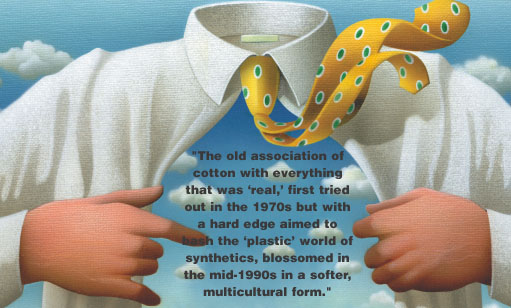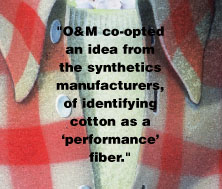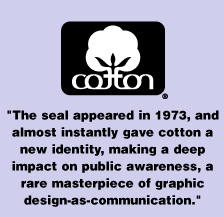

|
In the 1960s, the declining U.S. cotton industry
grappled with stiff competition from synthetic fabrics, competitive
international markets, and an outdated image. An unlikely alliance
between rural growers and urban admen helped restore American
cotton to its historic prominence. The co-authors of a new book
about cotton’s comeback spin a compelling yarn.
|


 otton
was the miracle fiber of the nineteenth century, when textile manufacturing
was the high-tech, high-growth business of the day. Like all farm
products, cotton was subject to the vagaries of the weather, pests,
and political risks, but for decades it sold into fast growing and
weakly contested world markets. On the eve of the Civil War, cotton
was “King”. Compressed in dirty white bales, upland cotton
from the American South was the developing nation’s largest export,
earning the lion’s share of its foreign exchange. It provided
the “satanic mills” of England with 92 percent of their
supply, and fueled the heart of industrial enterprise in the American
Northeast.
otton
was the miracle fiber of the nineteenth century, when textile manufacturing
was the high-tech, high-growth business of the day. Like all farm
products, cotton was subject to the vagaries of the weather, pests,
and political risks, but for decades it sold into fast growing and
weakly contested world markets. On the eve of the Civil War, cotton
was “King”. Compressed in dirty white bales, upland cotton
from the American South was the developing nation’s largest export,
earning the lion’s share of its foreign exchange. It provided
the “satanic mills” of England with 92 percent of their
supply, and fueled the heart of industrial enterprise in the American
Northeast.
One hundred years later, 300,000 American
cotton growers (cotton farmers are “growers”) were beset
with severe threats to their livelihoods. As the crop’s cultivation
had gradually expanded throughout the world, U.S. cotton had lost
ground in the global market. At home, in their biggest market, man-made
textile fibers – rayon, nylon, and polyester – had launched
a fearsome assault on cotton’s fabric and apparel business. Synthetics
producers were giant corporations, and had the financial muscle to
support research and promotion. 
Independent and small-scale as businesses
go, cotton growers were well organized for political purposes. Their
main concerns were to keep themselves from growing too much cotton
and to seek government support for research and relief from hard times
and market fluctuations. The National Cotton Council, created in 1939,
and its offspring, the Memphis, Tenn.-based Cotton Producers Institute
(CPI), had proven adept at influencing national farm policy. But as
the 1960s wore on, these organizations were not able to help growers
compete. Cotton’s share of the market for retail apparel and
home fabrics plummeted from 63% in 1960 to about 45% in 1970, on the
way to its historical low of 33% in 1975.
Farmers supply, but their fate is much
more the story of demand. It was clear that this most traditional
of American industries would need to embrace a fresh approach. Cotton
growers, always attentive to the problems of supply, would have to
learn how to market their crop. The industry was entrenched in 18
states spanning the Old South and new rural Sunbelt, but its new champions
would emerge from the urban corporate world: an advertising executive
from Connecticut, a graphic designer in San Francisco, and marketing
gurus of Madison Avenue.
In April 1970, half a dozen entrepreneurial
growers moved to save their industry. Through the agency of the CPI,
they sought professional help, and found it in the unlikely persona
of Dukes Wooters, an advertising executive at Readers Digest. Wooters
had a classic New England pedigree: the Taft School, Lehigh University,
military service in World War II, and Harvard Business School. He
knew next to nothing about cotton.
Blessed with an unforgettable name and
a deep arresting voice, Wooters was a hard-driving salesman, a marketing
man with great instincts for what would move off the shelves. At 53,
he had just turned-around the Digest’s sagging operation in Brazil
and was looking for one last great career challenge. “Dukes had
style,” one grower said. He shopped at Brooks Brothers, but to
prepare for his interview with the CPI leadership, he cruised through
Macy’s. “I looked around,” he said, recalling his surprise,
“and there was hardly any cotton.” Brooks Brothers was the
carriage trade; Wooters wanted to move cotton back into the mass market
by the trainload.
Clearing the Ground
No city was more closely identified
with a commodity than Memphis was with cotton. CPI’s research
staff was based there, and a small marketing organization, comprising
mainly Memphians, was lodged in tatter-down offices in the Empire
State Building. Wooters let them go, all but one. As Wooters tried
to explain to one nonplussed cotton grower, “you’re not
just raising a crop, you’re selling fashion on Seventh Avenue.”

To compete, growers would have to embrace
the big-city, consumer-driven culture of marketing. CPI’s headquarters
were moved to New York. Its research operations were transferred to
Raleigh, near North Carolina State University’s textile school
and near many of the country’s major cotton textile manufacturers.
Wooters determined that CPI would have to change its name, too. It
was a publicly funded body, but Wooters chose “Cotton Incorporated.”
He intended to run Cotton Incorporated as if it were “a real
company,” like Readers Digest or, for that matter, cotton’s
nemesis, that great innovator in synthetic fibers, DuPont.
Cotton Incorporated had a total annual
operating budget of just $20 million to pay for marketing, research
and administration. Its funds came from a voluntary contribution of
cotton growers channeled to it by the Department of Agriculture’s
Cotton Board (Today the assessments are mandated by law.) Yet the
company’s mission was ambitious, embracing almost every aspect
of production and distribution. Wooters saw the cotton market as a
continuous loop that bound thousands of growers to millions of consumers
through the good offices of textile mills, clothing manufacturers,
and retailers. The relationships all along the loop were dynamic and
interdependent. A “total marketing” approach was necessary.
Total marketing meant developing plans
to link the mills, clothing manufacturers, retailers and consumers
together into a mutually reinforcing chain of profit maximization.
The mills were the first customers, and they would be offered technical
assistance free of charge. Caring for them was crucial because they
preferred synthetics. Cotton, like wine, was highly variable in quality;
synthetics were uniform, easier and cheaper to process in volume.
Total marketing meant conveying back
to those engaged in research and technical services ideas from the
marketplace for new and improved fabrics and finishes. It meant arming
manufacturers and retailers with new fashion ideas that could be interpreted
in cotton and cotton-synthetic blends.
All that would be possible if, and only
if, mills, manufacturers and retailers were confident that the demand
for cotton was there. Most dramatically and publicly, Cotton Incorporated
would stimulate consumer demand with advertising and promotions, not
of cotton as an agricultural commodity – “that funny looking
white stuff,” as Wooters called it – but of cotton as a
brand.
Cotton’s Seal
The first step in converting cotton
from an agricultural commodity into a consumer brand was the creation
of a new image. Cotton, Wooters felt, had an image problem going back
a lot farther than the stodgy dungarees-and faded-cotton-frock-memories
of rural America. Ironically, the image of rural work clothes would
prove to be a key to cotton’s salvation.
While visiting Levi Strauss in 1971,
Wooters called on the noted designer Walter Landor in San Francisco,
who presented 12 versions to Cotton Incorporated. The chosen design
for the “Seal of Cotton” – one that Lander’s daughter,
Susan, had conceived, would become one of the most successful trademarks
in the annals of marketing. It was simple and engaging – a white
cotton boll, rising up from the two T’s of the word “cotton,”
laid against a background of earth-tone brown.
The seal appeared in 1973, and almost
instantly gave cotton a new identity, making a deep impact on public
awareness, a rare masterpiece of graphic design-as-communication.
The design conveyed several positive messages. If nature was good,
then cotton was good. Cotton had roots, but it also had bloom. Cotton
was pure, soft, comforting and natural. Cotton was something familiar
that you wanted to have and to keep around.
Creating Consumption
From its inception, the seal would stand
at the center of an intensive and innovative advertising campaign
designed to “pull” cotton back into consumer consciousness.
The broad middle class of consumers of Wooters’s generation –
those who came of age in the 1930s and 1940s – had largely forsaken
cotton for the wash-and-wear convenience and economy of synthetics.
But it happened that their children, however, the baby boomers born
between 1946 and 1964, were clad in cotton, or, to be more exact,
in denim.
Denim’s history reached back into
the nineteenth century. Though not indigenous in origin, denim –
used in dungarees or overalls – had become the quintessential
American fabric. In the 1960s, denim took on a new appeal for the
young. Blue jeans looked unkempt, required little care, were comfortable
and, most important, projected an image that rebuked the buttoned-down
fashion statements of the boomers’ parents’ generation.
An emblem of protest, jeans were bound up with rebellious acts ranging
from recreational drug use to civil rights and antiwar demonstrations.
The worry for cotton growers was that
boomers might abandon denim as they aged. The problem, then, was not
just to sell jeans to contemporary customers, but to do what synthetic
manufacturers had done so well: sell “fiber consciousness.”
In order to craft its own approach to advertising, Cotton Incorporated’s
marketing staff spent months studying the master, DuPont, the leading
synthetic-fiber manufacturer. What they learned was that they must
focus the market’s attention on the performance characteristics
of cotton garments.
Television Guides
Cotton’s consumer advertising began
in 1971. The medium was almost exclusively network television. This
tactic set cotton apart from other agricultural marketing programs.
The first ads in 1971, created by the Jack Byrne Agency, honed in
on a budding cultural notion that had its origins in the boomers’
counterculture of the 1960s: if something was “natural,”
then it must, somehow, be better. These ads carried the tag line “Cotton:
It’s a Natural Wonder” (with “Brought to You by Cotton
Incorporated and America’s Cotton Growers” tucked in at
the bottom of the screen). Viewers learned that they liked those scruffy
old blue jeans because “Levi’s‚ still makes them –
all 100 percent cotton.”
The effectiveness of Cotton Incorporated’s
advertising can be ascribed to the company’s long running relationship
with the advertising agency, Ogilvy & Mather (O&M), whose
co-founder David Ogilvy was an evangelist for branding. Cotton Incorporated
had little to spend by large corporate standards, and the dispersion
of its funds was politically sensitive. Hence, O&M faced a dilemma.
How could it create ads for cotton that were high impact yet cost
effective, carefully targeted and yet universally appealing? The seal
was key. Animated for television, it grew in a few seconds before
the viewer’s eyes, up from the good brown earth into a full-blown
soft, white cotton boll.
O&M found selective, high-impact
venues for cotton without breaking the bank. For example, Cotton Incorporated
focused most of its 1976 advertising dollars on the Olympic Winter
Games at Innsbruck in Austria. A fruitful media tie-in was cotton’s
regular appearance, starting in 1977, on NBC’s TODAY Show, an
association that vaulted Cotton Incorporated into the front ranks
of consumer advertising. As more cotton products were selected for
promotion, familiar television personalities delivered live commercials
on the set. Viewers saw Barbara Walters in a bright Hawaiian shirt
posed beside the Seal in a tropical setting, exuding confidence that
cotton was “doing a lot to make your life more comfortable. I
know it’s making my life comfortable right now.”
It all worked like a charm, producing
brand awareness and stimulating consumption. After one year, 18% of
consumers could identify the seal. By the end of 1976, when awareness
of the seal jumped to 46%, cotton’s market share edged upward
to 36%. (Today more than 70% of American consumers recognize the symbol,
even without the word “cotton.”)
The seal was used, for a transitional
period, to mark cotton-dominant “blends,” one way to help
re-capture market share. The 60/40% cotton/synthetic shirt became
commonplace on men’s store shelves. Then in 1977 and 1978, Levi
Strauss attempted a denim blend. The mix was modest (never more than
15% polyester), but the strategy was a marketing disaster for the
jeans maker. An aroused Cotton Incorporated pounded away at the heresy,
reminding consumers that the denim they had known and loved since
childhood was “100% cotton.”
A revised denim campaign featured pretty
young women viewed from the rear, in tight denim jeans, available
– along with lawnmowers, washing machines and power tools –
at your friendly hometown Sears. The implication was clear: in a world
filled with fakery, cotton was real. It performed the way you wanted.
Wearing it made you look and feel good, not just physically, but emotionally
too. The long-term message was: “Come home to cotton!”
Touting Performance
Cotton’s market share took off
in the 1980s, from 36 to 50%. The nation was emerging from a decade
that had included defeat in Vietnam, two oil shocks, rampant inflation,
and deteriorating competitiveness. The economy and corporate America
were now in the process of repair, and the nation’s mood edged
toward a new confidence. Cotton’s advertising voice grew more
confident, too.
O&M co-opted an idea from the synthetics
manufacturers, of identifying cotton as a “performance”
fiber. (This was a claim made possible by technical improvements in
cotton fabrics, driven partially by better breeding programs.) Television
viewers were wowed as ballerina Heather Watts pirouetted in front
of New York’s Lincoln Center and proclaimed the wonders of her
100% cotton Ship’n Shore™ shirts: “All cotton plus
permanent press: now that’s high performance.”
The “True Performance” campaign,
originated at Cotton Incorporated and developed and executed by O&M
evoked probably the most compelling image of cotton since coining
of the phrase “King Cotton” in the 1850s. Cyclists, sailors
and pole-vaulters strenuously “performed” in their cotton
duds, as “True Performance” dominated Cotton Incorporated
advertising through the eighties. The campaign included an elaborate
labeling effort at the retail level. Attractive “True Performance”
hang-tags, depicting the slogan and the Seal, appeared on millions
of garments in the biggest retailers and smallest specialty shops,
alike.
“True Performance” was
a watershed campaign. But demand for particular types of cotton apparel
and home furnishings, like demand for many other consumer products,
inevitably varied with fashion and the whim of consumer tastes. The
challenge therefore was to even-out these peaks and valleys by cultivating
loyalty to cotton as an essential component of the good life.
“The Fabric of Our Lives”
Dukes Wooters left Cotton Incorporated
in 1982, and in 1987, its president Nicholas Hahn took a new approach
to advertising. In focus groups and one-on-one interviews, people
were invited to talk about fiber, fabrics, garments, cotton, wool,
polyester, and anything to do with clothing. Something surprising
was discovered. Interviewees said that wool was warm and scratchy,
and that polyester was sticky, hot and did not breathe. But they also
professed “something” (they did not know what exactly) “about
the feel of cotton.” While talking about cotton, they tended
to touch themselves, whether or not they were wearing it. Some prompting
got subjects to talk about how they liked having cotton close to their
skin, and how little babies get wrapped in cotton, and other emotion-laden
images connecting cotton with life’s various stages. 
Based on this news, O&M concocted
the deceptively simple phrase, “The Fabric of Our Lives‚”
for a campaign that would become one of the most memorable in advertising
history. The documentary filmmaker Leslie Dektor’s avant-guard
realism, aimed at showing people as they were, did not talk about
performance features at all. The target audience had changed, so now
the message was intergenerational. Cotton was authentic, from “cradle
to grave,” not just for the baby boomers, but their parents and,
before long, their children, too.
For the launch of the Fabric of Our
Lives campaign, Hahn authorized an expenditure of $2 million of the
company’s $7 million advertising budget in one day – Thanksgiving
1989, the day before the single largest shopping spree of the year.
It was the day when families watched television dawn to dusk, from
the Macy’s Parade through professional football games to the
“Sound of Music.” Cotton commercials blanketed the screen,
as one hundred fourteen million viewers saw and heard them, over and
over again.
The size of Cotton Incorporated’s
expenditure enabled O&M to negotiate for reinforcing billboard
space. “Macy’s Thanksgiving Day Parade, Brought to you [in
part] by Cotton Incorporated. Cotton: The Fabric of Our Lives.”
Subsequently, O&M sought to sustain Cotton Incorporated’s
media “presence” with key franchise positions – twice
a week with Willard Scott on TODAY; beside Peter Jennings on ABC News;
on Late Night with Jay Leno; and on other highly rated shows.
Getting Emotional
Cotton and the good life went together,
like parents and children in happy homes. Cotton’s unvarnished
advertising “reality” confounded some critics, but it was,
in O&M’s word, “emotionally relevant.” In the late
1980s and 1990s, the linkage between liking a product and perceiving
it as authentic accounted for some of the great brand successes of
the era, like Starbucks™, The Body Shop™ and Virgin Atlantic™.
The old association of cotton with everything that was “real,”
first tried out in the 1970s but with a hard edge aimed to bash the
“plastic” world of synthetics, blossomed in the mid-1990s
in a softer, multicultural form.
In the 1990s, the Fabric of Our Lives‚
campaign embraced more modish themes. One ad featured an African-American
family, sitting around the dining room table in a reprise of the Norman
Rockwell image of Thanksgiving dinner. There are multiple generations,
nattily turned-out, nice up-market surroundings, lots of smiles. “How
different can we be,” went the voiceover for a spot featuring
a rainbow coalition of cotton-clad actors, “when we all love
to wear the same thing?” The actors in the ads appeared younger.
Research showed that turn-of-the-millennium teens and young adults
liked cotton well enough but displayed lower “fiber-consciousness”
than their parents. The job of educating the market was never-ending.
On the cusp of the twenty-first century,
an abrupt change occurred in workaday fashion that was tailor-made
for cotton. Corporate America went casual, and cotton supplied the
alternative, as male corporate America doffed its woolen suits and
female corporate America its linens and silks, for open collared shirts
and comfortable-fitting khakis. “What would it be like,”
came the question as the screen filled with diverse hard-working Americans,
“if we all dressed as if work were fun?”
Corporate casual dress, of course, was
a hallmark of the dot-com era. Yet while that particular bubble has
burst, cotton’s staying power has not. Consolidating the gains
it had made in the 1970s and 1980s, cotton closed the millennium with
a more than 60% share of the market for retail apparel and home fabrics.
What other industry (or company, for that matter) has ever lost nearly
half its market share and won it back?
Competition and Survival
The story of cotton’s renaissance
is not solely a story of consumer marketing. Dukes Wooters had envisioned
from the outset that Cotton Incorporated would have to meet rising
consumer expectations with ever-improving fiber quality, or gains
in market share could not be sustained. Competitive threats –
from low-cost synthetics and low-wage foreign producers – would
have to be checked with relentless quality improvements and cost-reductions
on the farm.
The practical result of his vision is
that the American cotton one wears today is far superior to the cotton
of forty years ago. It’s easier to fabricate and to care for.The
industry invests in research and development spanning fundamental
agricultural science to farm-level technological improvements. Today,
cottonseed research traverses the cutting edge of genetic engineering.
Cotton can be grown in colors. Enterprising growers invest in automated
tractors that can till the land to fine precision, locating their
positions with within two centimeters, day or night, in all weather,
increasing yields, lowering labor costs. And hungry textile mills
(though they have mostly moved overseas) get what they want most:
American cotton that is longer, stronger, finer, cleaner, and cheaper.
It’s a good thing, too. Cotton
growing is a ruthlessly competitive global enterprise. Cultivated
in more places around the world, cotton trades more freely than ever.
American growers have learned to manage demand but cannot administer
price. As quality has improved and as costs, and prices, have come
down, it has been a boon to consumers, a challenge to growers. Despite
mounting subsidies from the government, to compensate them for losses
in low-price commodity markets, the pressure on cotton growers to
deliver higher quality for less is unabated. Staying competitive demands
a high level of scientific and business sophistication. It requires
investment in technology, management, and marketing, and a broad-based
knowledge of world affairs, from the weather in Australia to political
conditions in Pakistan, from what’s fashionable in Paris to what’s
happening in the world’s genetic and biochemical laboratories.
In this dynamic environment, only the
strongest survive. Farms have consolidated to increase capital and
scale economies. Marginal land has been abandoned, given over to other
crops, converted into housing developments and shopping malls. That
some 30,000 cotton growers (just a tenth of the number in 1960!) are
still in business in the U.S., producing more and better cotton at
lower cost, is testimony to their collective mastery of the market.
George David Smith is clinical professor
of economics and international business at NYU Stern. He is a member
of the faculty of the Berkley Center for Entrepreneurial Studies.
Timothy Curtis Jacobson is a partner
in The Winthrop Group, Inc. This article is adapted from their new
book, Cotton’s Renaissance: A Study in Market Innovation (Cambridge
University Press).


![]()